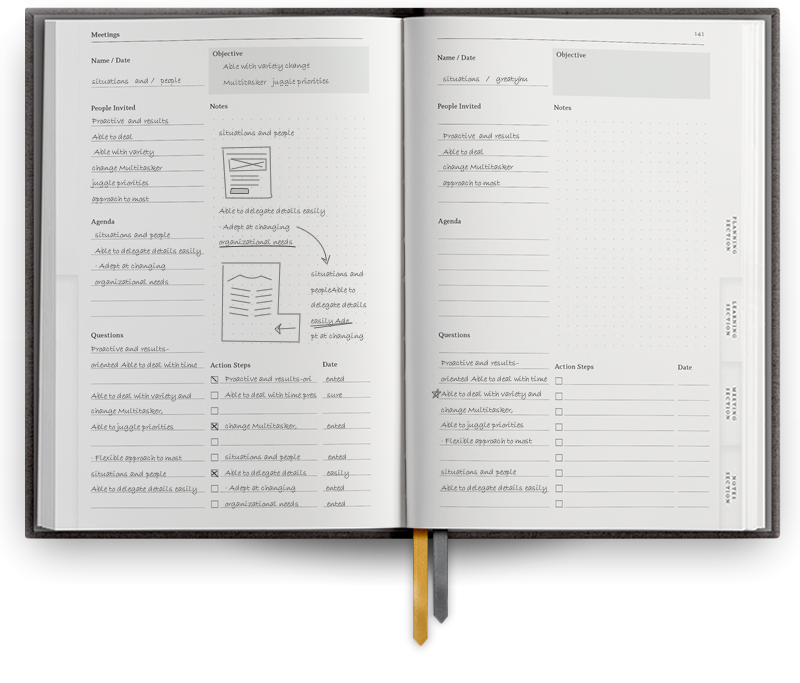PRODUCTIVE PASTOR
Meetings
Here’s a ton of questions to help you in your next meeting.

Running High Impact Meetings
The book “High Output Management” by Andy Grove introduces a concept called “Leveraged Leadership.”
Simply put leveraged leadership is any activity by which a small amount of your time, preparation, knowledge, vision, passion, or direction can have a massive impact on the people you lead.
I believe that no other activity we have as leaders has more potential impact on our teams then the weekly staff meeting.
90 minutes of your time will impact every hour a team member works and every ministry you oversee for the next 7 days!
What will you do this week, that has more impact than that?
Each week you have the chance to influence, guide, correct, direct, communicate, improve, coach and develop every area of ministry.
It just takes a little bit of preparation on your end.
The 8 Types Of Meetings
Often the reason people don’t like meetings is because they think they’re boring. Well yeah if each week is the same thing over and over with no sense of progress or momentum, I’d hate them too!
With these 8 types of meeting you can keep thing fresh and fun while at the same time keep the ball moving down field each and every week.
- S.T.E.P Goals
- Goals Follow-up
- Leadership Pipeline
- Personal Growth & Delegation
- 1 on 1
- Problem Solving
- Debriefing Big Events
- Leadership Workshops
For a more in depth training on all 8 meetings check out the
Staff Meeting Master Workshop!
S.T.E.P. Goals
Few things are more important to any organization then setting and pursuing the right goals.
S.T.E.P stands for Situation, Target, Evaluation, Planning
I recommend doing this 3 times a year. Winter, Summer, Fall
January with all goals ending by Easter
May with all goal ending before August
September with all goals ending before December
In this meeting we’re looking 12 months out but only setting goals for the next 3 months. This allows to reevaluate and adjust throughout the year without losing momentum.
This meeting gives you the opportunity to lead the team through several group activities that build on each other and end with a set of very clear tasks that, if done will lead each team to accomplishing their goals.
S.T.E.P. Follow up
Simply check in on the goals they set for themselves. I recommend you do this twice for each season.
Running a S.T.E.P. Goals Meeting
SITUATION – “Where are we?”
The goal of this time is to get an accurate picture of where each ministry is at the moment.
Ministry Life Cycle Exercise
Start by drawing diagram #1 and have each leader draw a dot/symbol where they think their ministry is at right now. Then have a group discussion asking everyone else if they agree with the placement. Most leaders will be hard on themselves and will mark the ministry lower than it really is. I usually ask “Why did you put there and not higher/lower?”
Keep an eye out for any ministry that lands in the red box in diagram #2. This is the danger zone, if you don’t act then the ministry could die! Usually being at the top of booming and the top of declining look/feel the same until it’s too late.
Typically when someone says they are at the top of booming it’s because they’ve run out of ideas, they don’t know where else to go. They’ve tried everything and now they’re in “maintenance mode.” If they had fresh ideas they’d move their ministry to the bottom of growing because they see tons of opportunity and they know growth is possible. This cycle of adding fresh ideas and possibilities is what makes a ministry everlasting and this is seen in diagram #3.
TARGET – “Where are we going?”
The goal of this section is for you as the leader to give clarity, direction and focus to help them dream and create impactful goals.
Framing Facts – Start by coming up with your 4 Framing Facts. These are statements that will help your team focus their attention in the right direction.
The first fact is alway time based, I suggest using 1 year. The following 3 have to be concrete measurables, usually numbers based. I usually pick one growth #, one leadership # and one stretch goal #. Here are some possible facts…
# in weekly attendance, # of services, # of volunteers, # of leaders, # of first timers, # of salvations/baptisms, # of locations/sites, # of staff, # of givers,
* ProTip – This activity is where you have the most leveraged leadership opportunity. If you can really thinking through having the right 4 Framing Facts, you could see a massive impact in every ministry of the next 3-6 months.
Write your 4 Framing Facts on the whiteboard and ask them, “If these facts were true, what would your ministry look, feel, and act like?”
Let them spend 10-15 minutes dreaming and creating a long list.
EVALUATE – “What’s the best way?”
The goal of this activity is to help them discover what big steps they need to take next.
Ask them– “Knowing where you’re ministry is at right now, and where we’re going, what needs to change in the next 12 months?”
Give them 10-15 min to create a list, then share that list with the group. Be sure to encourage feedback and ask for questions. This whole process needs to be collaborative.
PLANNING – “What our next step?”
The goal for this last section is to get clarity on what specific actions need to be taken now.
WIN – What’s Important Now – Ask each person to prioritize that long list form the last exercise into a top 6 list. Then share and let the group help influence their order.
AIP – Action Initiative Plan – Have each person take the top 3 goals and create an AIP.
Each big goal should be broken up into 3-5 smaller tasks that if done will make the goal a reality.
Each task should have….
A Due Date – These dates should be sequential so the task build up
A Point Person – Try to delegate a few tasks.
A Deliverable – A tangible way you as the leader know it’s finished.
Building A Leadership Pipeline
Here a few question you can use to help your team think through their leadership pipelines.
Want more info about how to build a Leadership Pipeline?
Checkout – www.MinistryLibrary.com/leadership-pipeline-workshop
- Who are you developing? Bus Principle
- What parts of your job are you delegating?
- How many leaders do we have at each level?
- How many do we need?
- How has your pipeline bench deepened in the last month?
- Who are the new potential leaders that you’ve identified? Which one most excites you?
- How many of your leaders and currently reproducing themselves? How are you helping them?
- How are you celebrating their reproduction?
- What is the biggest obstacle you see for continual reproduction of leaders in your area?
- What resources do you need?
- How can I help you?
Personal Growth & Delegation
I recommend writing these questions on a whiteboard and giving everyone 10-20 min to write their answers and then we take time to share our answers with the team.
- What do you need to learn in order to be a better leader?
- What do you want to learn more about?
- What are you doing to grow yourself?
- Who can you learn from?
- What character or competencies do you need to focus on in the next few months?
- What do you need to START doing?
- What do you need to STOP doing?
- Make a list of all the tasks you did last week.
- Of the tasks which are filling you up and which are draining you?
- Of the draining task, which are one you don’t HAVE to do?
- Can you effectively delegate those?
- Who can you delegate them to?
- When can you hand them off?
1 on 1 Meetings
1 on 1’s are some of the most exciting meeting I have. I think that when a leader gets to spend focused one on one time with a team member there is an opportunity for a huge amount of growth and productivity. I also find that my teams love these too!
- How are you doing? (personally & spiritually)
- What are you working one?
- What’s your biggest struggle?
- What are doing to overcome?
- What are your big goals?
- How can I help you?
- What should I start doing?
- What should I stop doing?
- What should I continue to do?
- Is there anything I’m doing that is wasting your time?
- Is there anything we haven’t talked about but should?
Problem Solving / 5 Whys & 4Ps
I don’t have this meeting scheduled on the calendar because you never know when major issue will come up but typically you’ll do this meeting 1-2 times a year.
I start with defining the problem. It seems obvious but getting clarity around the actual problem always helpful. I’ll write the problem on the whiteboard and then ask ….
Why did this happen?
Keeping asking why (at least 5 times) to find the root cause of an issue.
This practice is called “Toyota’s 5 Whys”
Usually it’s one of the 4 P’s – The 4 P’s are People, Products, Process or Policy.
I find that when there’s an issue, it’s usually a person, a product, a process or a policy that is causing the issue. Go through the 4 P’s and brainstorm through how to fix, tweak or eliminate these issues
Debriefing Big Events
Maybe it’s Easter, Christmas, or a Community Event, we all have big events and if we’re not evaluating them correctly they can become sacred cows that pull away time and energy.
I use these question to help continually improve each big event we do.
DUPLICATE
- What did we do well?
- What worked best?
- What do we know we want to do again next time?
DUMP
- What do we not need to do again?
- What didn’t work at all?
- What was the most draining effort, but produced little or no return for the investment?
- What is tired, worn out, ready to be laid to rest before we do this again?
- What was missing/confusing?
DEVELOP
- What was good, but could be better?
- What did we learn?
- What strengths did we see in a specific person or team?
- How can we improve our teamwork, systems or communication?
- Where did we see the greatest energy, that with a little more effort could be huge?
- What do we know is a part of our values for the event — or for our church (or organization) — but it didn’t get enough attention?
DREAM
- What’s the wildest idea we could think of to do next time?
- What could we add next time that has the potential to be a “signature” aspect?
- If money was not an option, what would we do to make this better?
